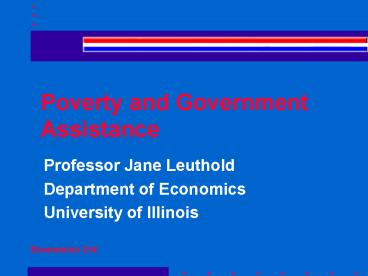Lecture Title - PowerPoint PPT Presentation
1 / 26
Title:
Lecture Title
Description:
... Assistance. Professor Jane Leuthold. Department of Economics ... Poverty at home. The nation's poverty rate dropped from 12.7% in 1998 to 11.8% in 1999. ... – PowerPoint PPT presentation
Number of Views:17
Avg rating:3.0/5.0
Title: Lecture Title
1
Poverty and Government Assistance
Professor Jane Leuthold Department of
Economics University of Illinois
Economics 214
2
Topic for today ...
- How serious is the problem of poverty
- in the world?
- in the United states?
- Income inequality is it increasing? Why?
- Why is the alleviation of poverty a government
problem? - What do the candidates think?
3
World-wide poverty
- In 1998 1.2 billion people world-wide had
consumption levels below 1 a day -- 24 percent
of the population of the
developing world and 2.8 billion lived on less
than 2 a day.
4
Trends in world poverty
- Proportion living in extreme poverty has fallen
from 28 in 1987 to 24 percent in 1998. - Eight out of every 100 infants do not live to see
their fifth birthday. - Nine of every 100 boys and 14 of every 100 girls
who reach school age do not attend school.
5
Poverty at home
- The nation's poverty rate dropped from 12.7 in
1998 to 11.8 in 1999. - Real median household income reached 40,816, the
highest level ever recorded by the Census Bureau.
6
Measuring poverty
- The poverty threshold defines subsistence income
for urban and rural families of different sizes - In 1999, the poverty threshold was 17,000 for a
family of four.
If you work full time (2000 hours/year) and the
minimum wage (5.15/hour), what is your annual
income?
7
Poverty rate over time
8
Poverty of children in the US
- Roughly one child in 6 is now considered poor
(16.9 in 1999), and 38 of the poor are
children. - The poverty rate in mother-only families is
around 50. - More than half of all children will spend some
portion of their minority years in a
single-parent household.
9
Poverty by age group
10
Poverty by race
11
Household income inequality
12
Changes over time
Source Bureau of the Census
13
Lorenz curve
100
Gini coefficient A A B
Line of Equality
Cumulative of income
A
Gini 1967 .399 1998 .456
B
100
Cumulative of families
14
Inequality over time
15
Explanation
- Higher returns to education?
- Increased labor force participation and earnings
of women? - Weaker unions?
- Intensified global competition and immigration?
- Erosion of the minimum wage?
- Increased divorce rates?
- ???
16
Returns to education for men
17
Returns to education for women
18
Growth in earnings
19
Poverty and market failure
- Interdependent utility functions -- when the
well-being of those less fortunate affects ones
own utility - Negative externalities
- reduce social unrest
- reduce crime
- Uncertainties make it difficult to insure ones
own future
20
Income assistance as a public good
MB MC
MB
Private charity alone will lead to too little
income assistance because of the free rider
problem.
MC
MBLiberals
MBConservatives
I
Income assistance
21
Rationale for public assistance
- To address the public good aspects of poverty
(interdependent utility functions) - To account for the negative externalities (crime
and social unrest) - To provide a social safety net (insurance against
adversity)
22
Discussion
- What are some ways government could encourage
voluntary contributions from free riders? - What stands are the Presidential candidates
taking on the issue of poverty? Do you think the
median voter theorem is influencing their
positions? Explain.
23
Candidate Gore
- Supports the current child tax credit
of 500 and making it refundable for
nontaxpayers. - Supports extending the deduction for
charitable contributions to those
taxpayers who do not itemize. - Supports increasing the Earned
Income Credit earnings threshold.
24
Candidate Bush
- Supports doubling the child tax
credit to 1,000. - Supports extending the deduction for
charitable contributions to those
taxpayers who do not itemize. - Supports eliminating the estate tax
by 2009.
25
Soap Box
Search the Net to find out what your state has
done to assist recipients who receive funds under
the Temporary Assistance to Needy Families (TANF)
program in developing work skills and finding
work. Describe one aspect of the TANF program in
your state and explain why you think it will or
will not help reduce poverty and dependency. If
you are from another country, describe briefly
what your country is doing to address the problem
of poverty.
26
Next time ...
Thurs Welfare Reform Text pages 245-250
268-269 271-282































